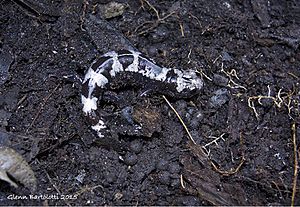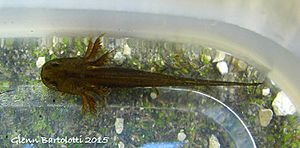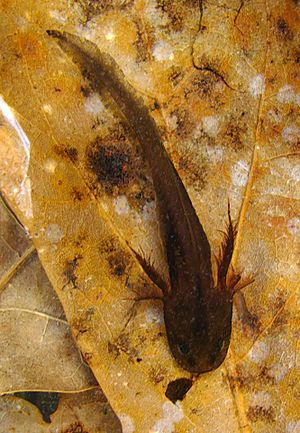Marbled salamander facts for kids
Quick facts for kids Marbled salamander |
|
|---|---|
 |
|
| Conservation status | |
| Scientific classification | |
| Genus: |
Ambystoma
|
| Species: |
opacum
|
The marbled salamander (Ambystoma opacum) is a species of mole salamander found in the eastern United States.
Description
The marbled salamander is a stocky, boldly banded salamander. The bands of females tend to be gray, while those of males are more white. Adults can grow to about 11 cm (4 in), small compared to other members of its genus. Like most of the mole salamanders, it is secretive, spending most of its life under logs or in burrows.
Habitat and range
Marbled salamanders are found in the eastern United States, from southern New England to northern Florida, and west to Illinois and Texas. They have been found as far north as New Hampshire, though only two sightings have been reported there. Their habitats are damp woodlands, forests, and places with soft and wet soil. Seasonally flooded areas are essential for breeding, but the salamanders do not normally enter the water. Like many salamanders, marbled salamanders have poison glands to deter predators.
The marbled salamander is the state salamander of North Carolina.
Lifecycle and reproduction
Lifecycle
Adults spend most of their time in their burrows or under logs, as is the case with most mole salamanders. Juvenile marbled salamanders hatch early compared to most salamanders and gain a size advantage by feeding and growing for several months before the Jefferson salamanders and spotted salamanders hatch later in the spring. Larvae typically mature as quickly as two months in the southern part of their range, but take up to six months to mature in the northern part. Marbled salamanders, like other members of this genus, are reported to have relatively long life spans, 8–10 years or more.
Reproduction
Courtship of this species takes place on land. The males will compete by butting heads and blocking another male’s movement with its tail. When courting the female, a male will nudge the vent of a female with its snout, with the intent that the female will respond in kind. This back-and-forth nudging has the appearance of a dance as the two salamanders circle around one another. This display culminates with the male depositing a spermatophore and the female moving to take it into her cloaca. The female will then lay between 50 and 200 eggs, often remaining with them until the nest floods.
Feeding
Adults take terrestrial invertebrates, such as worms, insects, centipedes, and mollusks (snails, slugs). Larvae take small aquatic animals (zooplankton), but larger individuals will take eggs and larvae of other amphibians, as well.
- Gravenhorst JLC. 1807. Vergleichende Uebersicht des Linneischen und einiger neuern zoologischen Systeme ... Nebst dem eingeschalteten Verzeichnisse der zoologischen Sammlung des Verfassers und den Beschreibungen neuer Thierarten, die in derselben sind. Göttingen: Heinrich Dieterich. xx + 476 pp. (Salamandra opaca, new species, p. 431). (in German).
- Petranka, James W. (1998). Salamanders of the United States and Canada. Washington, District of Columbia: Smithsonian Books. 592 pp. ISBN: 1-56098-828-2.
- Tyning, Thomas F. (1990). A Guide to Amphibians and Reptiles. Stokes Nature Guides. New York: Little, Brown and Company. 416 pp. ISBN: 0-316-81713-9.






